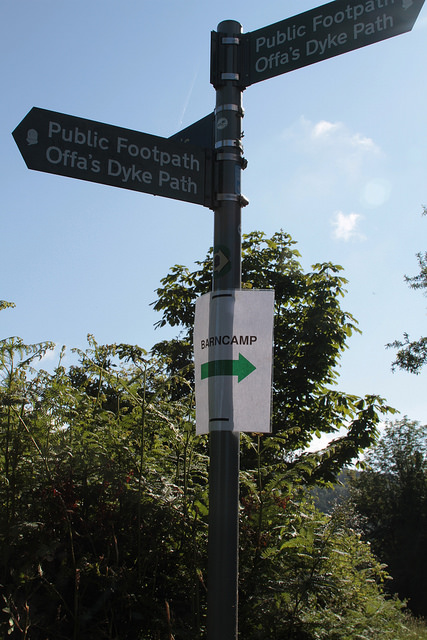 It all started back in November at the Autumn/Winter HacktionLab gathering at the 1-in-12 Club in Bradford. I'd tabled the idea of doing another BarnCamp and we agreed that this was a good idea and that some of us were up for helping with it.
It all started back in November at the Autumn/Winter HacktionLab gathering at the 1-in-12 Club in Bradford. I'd tabled the idea of doing another BarnCamp and we agreed that this was a good idea and that some of us were up for helping with it.BarnCamp is a rural skills-sharing event that takes place in the UK and conceived of and run by HacktionLab
Well 2015's BarnCamp's in the bag and again people have asked for a write-up-cum-HOWTO-cum-workshop on how to put together a BarnCamp. I've tried to do this before (see links at end of the article), but here's another attempt in the form of a personal report on what happened this year.
 It all started back in November at the Autumn/Winter HacktionLab gathering at the 1-in-12 Club in Bradford. I'd tabled the idea of doing another BarnCamp and we agreed that this was a good idea and that some of us were up for helping with it.
It all started back in November at the Autumn/Winter HacktionLab gathering at the 1-in-12 Club in Bradford. I'd tabled the idea of doing another BarnCamp and we agreed that this was a good idea and that some of us were up for helping with it.
Pretty much not a lot happened then for some months. Well I sent out and email to the HacktionLab mailing list regarding when we should do it, but didn't get much of a response; the date we went for was not the most popular but the one that a key BarnCamper of previous events was the most insistent that was a good date for them. We also discussed that there were a couple of other similar events on round the same time. Thus, the date was chosen.
In about February we dug out the old BarnCamp registration website and did some updates to improve it. The three of us in the getting-it-off-the-ground team worked a little on website content on the site and on the Wiki trying to spruce it up. We didn't really do much marketing this year at all, mostly our own websites and then posts from Indymedia UK, various other personal sites, and yes, Facebook, which garnered (true to previous form) no additional attendees, but a few maybes.
Ben Green and I did a talk at this year's Bristol Anarchist Bookfair (seems to be an annual gig for us) and used this to promote BarnCamp and hand out some flyers, and this garnered some more folk. We also emailed out to 2013 and 2011's attendees to let them know the event was happening. Sign-up gathered pace.
Sign-up was slower than in 2013, when we'd done more promotion (me and others had carted flyers around to at least four events during the prior year and even run stalls), and was looking quite low even well into the first week of June. It then picked up considerably, and we ended up with the roughly 70 maximum attendance we had, less than the 110 of 2013, but with a more intimate and organised outcome in my opinion.
What else did we do prior to the event, well:
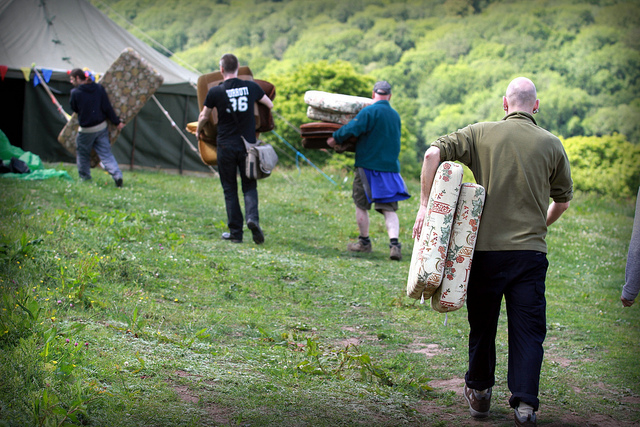 The key thing is to try to get the right equipment and a great bunch of people on site and then empower them and let them do their magic, which they will with fantastic results.
The key thing is to try to get the right equipment and a great bunch of people on site and then empower them and let them do their magic, which they will with fantastic results.
I really advise rejecting any idea that appears to complicate matters! If someone has an idea of something that they can do, that they can bring on site and set-up autonomously then it's a good idea; however, if it requires sourcing of lots of equipment, borrowing this or that, finding a van and driver and five people to make it work, I recommend rejecting it as too complicated. In short, keep it simple and make sure you know that it can be done. As an example. A couple of years back a keen person said they'd like to sort out the showers. "Great!", I thought, "go for it!" and ticked the item of my production list. Then some time after that I got a call from them asking for tarps, palettes, hoses, this, that and the other. That wasn't really sorting out the showers, that was creating a list of more stuff to get and more work. I know that may sound a little dismissive of and negative towards new ideas, but really there are far many more good ideas than hands to put them to work, so sometimes it's best to keep them to yourself!
The equipment? Well, there's lots! Mostly between myself, OARC, Bristol Wireless and a couple of other BarnCampers we had nearly all of it already (stashed each year in a lock-up for the next time). This is just because over the years we've gathered it for one reason or another, but mostly, for me, because it allows me to do events and to know that I have the necessary equipment that does what's needed and is in working order. I tend to try to an audit of it a couple of months before an event; at worst at least a couple of weeks. It's important again to have working equipment, and this harps back to the good ideas thing above. It's no-good someone saying they'll bring a PA, if they bring a knackered old PA with tangled leads that need soldering and speakers that have been home to their pet rat, and they turn up two days late and then need lots of help to set up right in the middle of the event. Easier is to ensure you have a PA that works, or you have someone on the crew that can ensure that, or simply hire one for the event.
Here's a list of some of the kit we needed to bring:
Here's some of the things that Highbury Farm provided on-site, either because they were there already or at our behest:
BarnCamp is quite a loosely run event, with no tickets as it's not a for-profit event. The sign-up form on the website is used primarily to gather information about the participants, such as what they're interested in doing there, helping with, any ideas for workshops and sessions, whether they are bringing kids and any dietary requirements. We also ask for a donation towards the event with a recommended amount and ask that people pay up from. Paying up front helps with cash-flow to cover the initial outlay, purchasing food and refreshments mainly. We had about 70 people attend this time and about half of them paid up front. This helped a lot, but it would be good if more did pay up front as it saves individuals having to bank-roll it.
The list of signups is then exported just before the event, or when the number of signups reaches the maximum and copied over to a computer we have solely for the purpose of the Welcome Desk (more on that in a bit). On the desk we used a spreadsheet to keep track of the number of people who were coming, when roughly they were to arrive and to establish if they'd paid up front.
By using unique attendee codes that are assigned upon sign-up, we were more easily able to track any payments into the bank account, so long as people had used the code as their payment reference, so it's key to persuade them to do this.
The most critical thing about knowing numbers in advance, is so that the kitchen knows how many people they're going to be cooking for any meal. This is pretty crucial. One of the key limitations on the number of attendees at an event is the number of heads to cook for. Our kitchen could probably stretch up to 100 people as it is, but this would need to be larger for a larger number of people, meaning more crew, more food and consequently more cost up front. Finally on that note, food is expensive stuff, and it's good not to have bought too much, just as it is not to have bought too little. This year we guessed pretty good, in that we had more than enough food for everyone; actually we had a little bit too much, so some money was 'lost' there. At least we didn't have to rush out and buy more right in the middle of the event, which is not so desirable as it takes important crew away from site for a while.
We also sold refreshments at very reasonable prices and this effectively balanced the books enabling us to end the event in the black. In order to keep the recommended donation down to £35 in advance (£40 on the gate), we did need to do this. The event wouldn't have broken-even at that amount without the input.
Finally, we went for a sliding scale of donations, allowing people to choose to contribute less (as low as £25) and more if they could afford it. This worked well and lots of people did contribute more than the recommended donation; and some choose to make a lower donation to the kitty. To compare my experience from previous years, I think it worked well giving people the opportunity to choose to contribute less. Previously we had asked people to email us to request this, but this simply led to more administrative work before the event. I was pleased to see people contributing more as well, and at a rough glance it looked like things balanced out.
Lastly I would like to add that I took a fairly lax approach to finances and didn't count every float out, float in and where every penny went. This may have meant that we didn't optimise our finances, but again meant that the administration was very light-weight and manageable. In my mind, so long as HacktionLab came out of it without less money in the coffers than at the beginning, then job done. Obviously the more exacting amongst you might find this approach rather too lax, and we'd obviously welcome someone that wanted to keep a tighter reign on things.
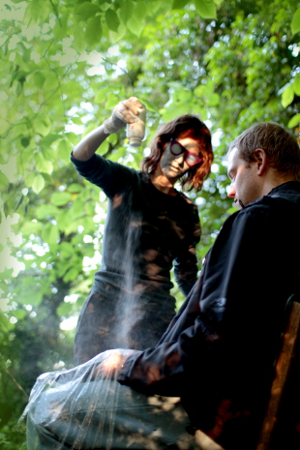 BarnCamp runs officially from Friday to Sunday, but folks are on-site from the Wednesday until around lunchtime on Monday. The key thing that worked well this year was that we had a reasonable number (one could say optimal) that arrived on the Wednesday to start setting up. Sam also arrived on Wednesday. The end result of this is that we were fully up and running by mid-afternoon on Thursday and therefore able to focus on content and production and not infrastructure. This is important to making it a success and less stressful. In the past we were still stetting up on the Friday, when lots of people had arrived, but weren't able to harness the extra hands. Here's a set of pointers:
BarnCamp runs officially from Friday to Sunday, but folks are on-site from the Wednesday until around lunchtime on Monday. The key thing that worked well this year was that we had a reasonable number (one could say optimal) that arrived on the Wednesday to start setting up. Sam also arrived on Wednesday. The end result of this is that we were fully up and running by mid-afternoon on Thursday and therefore able to focus on content and production and not infrastructure. This is important to making it a success and less stressful. In the past we were still stetting up on the Friday, when lots of people had arrived, but weren't able to harness the extra hands. Here's a set of pointers:
I feel that the production meeting idea worked really well. We had this fairly near to the start of things. Previously we'd scrabbled around trying to set things up in a slightly chaotic fashion. The production meeting meant that everyone there was instantly a member of the production crew, was responsible for setting something (or various things) up, and we knew who might need help with what. The production meeting used the various areas of site infrastructure as it's focus and gave jobs to everyone - see Wiki page for details of site set-up requirements that we used for the meeting.
We did focus on the important things to set up first, which were the refreshments area (for the evening), the breakfast area (for the morning) and the marquee. The marquee is obviously something you don't really want to set up in the rain or in a strong wind, so we chose our time, and we made sure we had the right number of people. Again this is important. An optimum number for us was about eight (given our experience at doing it and the type of marquee). Too few would have made it more dangerous and difficult to do, and too many would have meant too much opportunity for people to be hanging around, chatting and getting in the way. Also, what is important is to have one or two people who have done it, or something similar, before. This enables them to show others and helps with skills-sharing in itself, and makes it safer.
We did well on the Wednesday and got a lot of stuff set up. Another key here was to encourage everyone to go and get they're tents set up first, before doing anything else. Therefore, everyone felt settled in and had nothing more to worry about other than helping to set up BarnCamp and heading for the pub for some grub in the evening.
Oh yes, a point I should mention: We didn't have any on-site food on Wednesday or Sunday evening. As we plumped for a cold breakfast, save some porridge, it meant that we could rapidly get the breakfast table up and running ready for the next day. The guys at Highbury Farm made a simple (soup and bread), yet delicious lunch to take the pressure off our own kitchen, which was then ready for Thursday evening in a relaxed fashion. So, it's a good idea to have some scaled down catering for forward crew, possibly provided by a different crew to again take the pressure off.
Having not drunk too much, nor stayed up too late, we were able to have a productive meeting on Thursday morning. The goals of the meeting were to review what we had left to do, see who needed help with what, and bring in any newcomers so that they could immediately lend a hand.
I had the idea of having a stand-up meeting to do this. Stand-up meetings come from the world of Agile and are generally used in software development teams, but can actually be used for any purpose. We ran the meeting thus:
This had the effect of being very quick (10 minutes I think) and quickly established who was already engaged in stuff to do and needed help with it and also allowed the newcomers to quickly understand who was who, what was going on, what was needed doing, and who to team up with to get it done.
My perception is that we ended the stand-up with everyone going off to do something and this meant that in very little time, we had everything done.
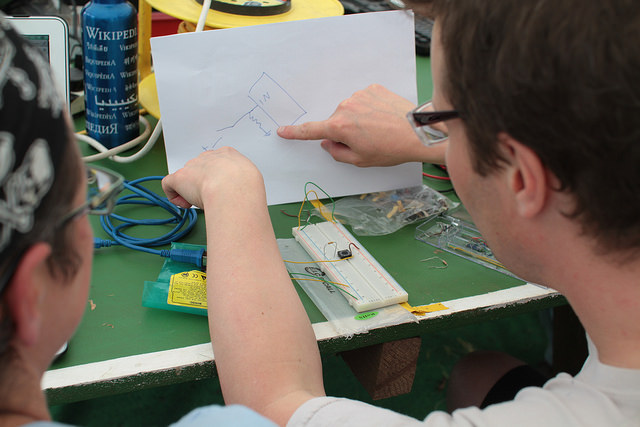
We've long tried to incorporate a free flowing programme for the event that allows people to do what sessions they wish with whom is most interested. This is variably known as open space, bar camp, birds of a feather and other terms besides. In the past we had some fixed sessions with some open space sessions, but this time we went purely for open space sessions, and I think it worked splendidly (my hat off to those of you that organised this part). What we did was this:
During the production meeting we decided/confirmed the structure of the programme - what slots there would be over the three days with lengths and start and end times, meal times and plenary sessions clearly marked. This went up onto a huge chart on the wall that was easily visible in the main space.
Anyone who came to BarnCamp could then propose a session by writing it onto a square of paper and then fitting it into the programme as and when they preferred. This seemed to have the effect of a really free-flowing DIY programme that suited what everyone wanted. Although I must say that I wasn't closely involved in this part of it and I know that there was a little post-production with some slots being moved to make the programme work better. The great thing was that everyone who wanted to be was involved, meaning that this potentially onerous task wasn't the sole responsibility of one or two people.
In addition to full slots (one hour or even two spanning two sessions), we also had several sessions of short presentations (from 5 to 20 minutes) that again people could put up themselves. These are again know by various names, such as lightening talks and microslots, but we called them xPress Slots. I think this worked really well as it gave people the opportunity to present a work in progress or just say something about something they'd worked on or were interested in without them having to have a pre-prepared workshop or talk. It also meant that we didn't suffer from programming in something that really was 10 minutes of content into a slot lasting an hour; this kind of thing is generally negative for both presenter and audience.
Our programme had sessions in three spaces this year, which seemed about right for the number of people in attendance. The main spaces were the Barn and the Marquee, both with power and projection and sound facilities, and Other, which this year ended up being mainly the party tent, that we'd previously used for the kids space. In addition, some things took place outside sitting in the field, and even in the woods and hedgerows, in the case of the Wild Food Walk and Tantric Laptop Healing sessions. Having been transformed into a workshop space (initially for the introduction to electronics workshop) the party tent quickly gained a table, chairs and some power.
We defined a role called Production Manager for the three days of Friday, Saturday and Sunday. This role was a person who would be responsible for making sure things happened roughly on time and that they could happen, in that they had the right resources and were in a suitable space.
This is a key role as it means that there's a person who everyone knows to go to for the day. We rotated it this year, with the roles clearly marked on the info board. I had done this previously, as well as doing too many other things, and in 2013 I have to say that I (and colleagues) lunched it cos there was too many other things going on. This meant that things didn't start on time, weren't in the right place, time-keeping was generally vague, and people got a little frustrated. We also failed to have morning plenaries and any closing circle, which I feel are really important for the continuity and inclusiveness of the event. Luckily this year, we shared out this role with a different person doing it each day, and even two people doing morning and afternoon on Saturday, which is the busiest and most hectic day. In the end I didn't even do any of it, which was great and allowed me the space to do my favourite thing, which was to run the stage on the Saturday night.
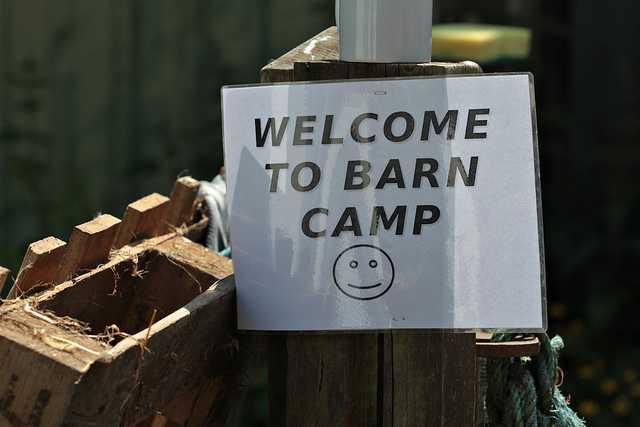 It was for the third BarnCamp (in 2010) that we originally came up with this idea, and I feel that this year it worked really, really well. The desk serves as the cornerstone to a DIY event much more than at a non-DIY event as it enables people to find out what they can get involved in and get involved. In addition, it means that anyone arriving can find out about the normal site-related stuff such as where to camp, where the loos are, how to find out about what's on, mealtimes and essential heath and safety point.
It was for the third BarnCamp (in 2010) that we originally came up with this idea, and I feel that this year it worked really, really well. The desk serves as the cornerstone to a DIY event much more than at a non-DIY event as it enables people to find out what they can get involved in and get involved. In addition, it means that anyone arriving can find out about the normal site-related stuff such as where to camp, where the loos are, how to find out about what's on, mealtimes and essential heath and safety point.
We made the role of Welcome Desk Co-ordinator, which I think is essential. The co-ordinator then recruited people to person the desk during the event, but was there to keep an eye on things and make sure that the desk was peopled at peek times. We didn't run the desk 24x7 but opened it at towards the end of and for some time after any time when everyone would naturally be gathered together, such as meal times and during plenaries. The co-ordinator liaised with the production managers and those organising the programme.
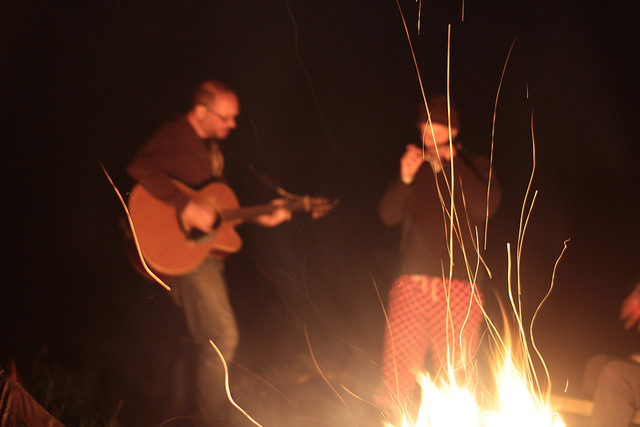
After a full day's nerding, it's always good to have something in the evening to switch off to. It's various has seemed to be a bit of a sticking point trying to tie some activities together, although this year I think we cracked it. Over the years we've settled on having a film night in the Barn on Friday night and then some live entertainment on Saturday night; this seems to work as a formula.
From past experience the lesson learnt has been keep it simple and trying not to be too ambitious. The key is always equipment and then production during the evening. We had just enough kit (see list below) with us to ensure that we could handle what come up, and we'd tested it in advance to make sure it worked.
For the Saturday night we had some great content varying between using the screen to live performance on the stage. Here's what was on the agenda:
This was kind of organised in an open-stage format, as in attendees were invited to propose and then come and do their thing. Gettting Suzy in as a booked act was an excellent idea as it meant we had something to hang everything around and having a live performance is good. We didn't have as many proposals as some years, but what we did get right this year was to start earlier, as in 2013, it got vagued until quite late and a lot of potential performers had gone to bed.
There's always been a bit of a conflict between the Barn and the Fire, but I feel that starting earlier this year meant that this wasn't so much of an issue. We'd finished by around midnight, when things had definitely got a bit dark and people were ready for the fire.
One thing I learnt was not to bother trying to perform as some de facto act and instead focus on the sound desk and general stage. This made things much less stressful (obviously) although I could have done with another person to make breaks easier, oh and also people to bring me drinks from time to time.
Taking the accoustic stuff to the fireside later on also worked well; at least for me and Ben, if not those who were subjected to us.
Here's a rough kit list:
The party's over and everything needs to be packed away. People also wish to get home too (well some do at least). It's key to get this balance right. I've been in situations where everyone's buggered off and there were just a few of us left to clear up an awesome mess! So again many hands make light work, but also things can get really messed up at this point. Who hasn't ended up with someone else's something or other, whilst having lost something themselves? Who hasn't found things not where they ought to be or scrunched up? There's also an order you need to load a van so that everything fits in and nothing gets damaged; it's a little like group Tetris.
There's been quite a few thoughts along the way with this article, but here's the summary of the main lessons I've learnt along the way (in no particular order):